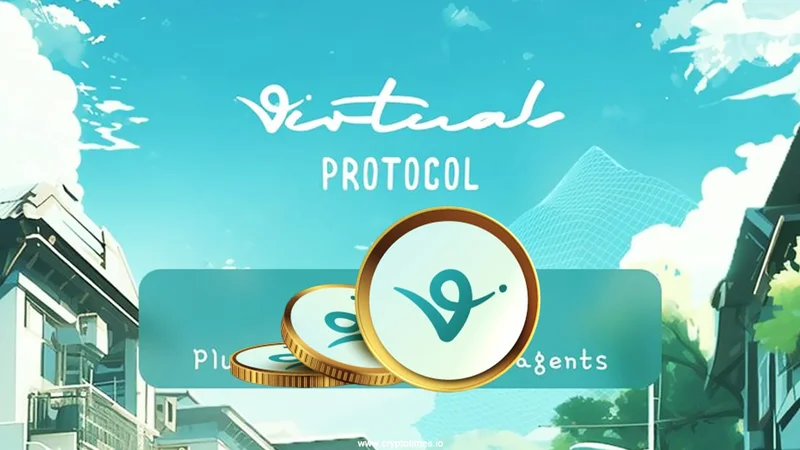XLM Insight | Stellar Lumens News, Price Trends & Guides
XLM Insight | Stellar Lumens News, Price Trends & Guides
Forget the charts. For a moment, let’s push aside the dizzying 100% price surge and the flashy new listing on OKX. Those are just the symptoms, the surface-level tremors of a much deeper, tectonic shift happening beneath our feet. What we're witnessing with Virtuals Protocol isn't just another crypto rally; it's the sound of a new economy waking up. An economy run not by people, but by autonomous AI agents.
For years, we’ve talked about the "Internet of Things" or the "machine-to-machine economy" as a far-off, abstract concept. It was always a "someday" technology. Well, someday just arrived. When I saw the on-chain data for Virtuals, I honestly just leaned back in my chair. The weekly agent-to-agent transactions exploded from under 5,000 to over 25,000 in a single week. This is it. This is the kind of tangible, explosive growth that turns a theoretical whitepaper into a living, breathing ecosystem.
This isn't just random noise. It’s a direct consequence of a breakthrough that I believe will be as fundamental to the next decade as the web browser was to the 90s. And the market, for once, seems to be pricing in the future, not just the present.
So what was the catalyst? What flipped the switch? The answer lies in a beautifully elegant piece of technology: Coinbase's x402 protocol.
Now, stay with me here. This is all built on the x402 protocol—in simpler terms, it’s an open-source language that lets AI programs pay each other for services directly, instantly, and on-chain, without needing a clunky subscription or a user account. It’s a universal standard for value exchange between machines. Think about that for a second. We just gave AI a wallet and the freedom to use it.
This is the digital equivalent of the first handshake between two merchants on the Silk Road. It’s a protocol for trust and transaction where none existed before. Before this, AIs were powerful but isolated, like brilliant minds trapped in soundproof rooms. They could compute and analyze, but to get paid or pay for a service, they needed a human to step in and handle the finances. The x402 protocol smashes those walls down. It’s like giving every AI agent a universal credit card and an internet connection, allowing them to do business with each other at the speed of light, without ever asking a human for permission.

And the data shows this isn't some far-off future concept—the weekly agent-to-agent transactions exploded from 5,000 to over 25,000 in a single week which is just a staggering signal that the flywheel has already started turning. It's no wonder that Jesse Pollak, the Head of Base, is so publicly proud of the ecosystem, or that analysts are calling VIRTUAL "one of the strongest altcoins right now." They aren't just looking at a ticker symbol; they're looking at the first vital signs of a new form of economic life.
When a new, foundational technology is born, you don't immediately see skyscrapers. You see the first roads being paved. That’s what we’re seeing now. The 240% week-over-week increase in large, "whale" transactions isn't just speculation; it's smart capital recognizing that the ground floor of a new paradigm is being built. The daily active wallets climbing past 10,000 aren't just users; they are the first citizens of this nascent digital nation.
This is bigger than just one protocol or one token. This is about creating the infrastructure for autonomous commerce. Imagine AI-powered trading tools that can instantly pay other AIs for a millisecond of proprietary market data. Or a swarm of robotics in a warehouse that can bid and pay each other for electricity to recharge, optimizing the grid in real-time. This isn't science fiction anymore. The integration with Virtuals is the proof of concept, the first real-world stress test.
Of course, with any great leap forward comes immense responsibility. We are laying the groundwork for an economy that will operate at speeds and scales beyond direct human oversight. How do we build the guardrails for an economy that operates at the speed of light, literally? What are the ethics of autonomous agents controlling and exchanging massive amounts of value? These are not questions for tomorrow; they are questions for right now. We have to build this future with intention and foresight.
But the potential is breathtaking. We’re moving from a world where humans instruct machines to a world where machines collaborate with other machines. OKX Lists VIRTUAL Amid Surging Interest and Price, the price targets of $2 or $3—these are just milestones on a much longer journey. The real question we should be asking isn't "What will the price be next week?" or even What’s Behind the 100% Virtuals Protocol (VIRTUAL) Price Rally?, but rather, "If AIs can now pay each other for data, for computation, for tasks, what new kinds of services and businesses will emerge that we can't even conceive of yet?"
Let's be clear. The recent market frenzy isn't the story. It's the footnote. The real headline is that we have, for the first time, created a viable, scalable, and open standard for machines to economically interact with one another. We've built the railroad. Now, watch as a new world gets built alongside the tracks. This is the beginning of the autonomous economy, and it's happening right now.